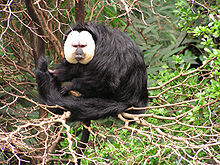White-faced saki
| White-faced saki[1] | |
|---|---|

| |
| Male | |

| |
| Female | |
| Scientific classification | |
| Domain: | Eukaryota |
| Kingdom: | Animalia |
| Phylum: | Chordata |
| Class: | Mammalia |
| Order: | Primates |
| Suborder: | Haplorhini |
| Infraorder: | Simiiformes |
| Family: | Pitheciidae |
| Genus: | Pithecia |
| Species: | P. pithecia
|
| Binomial name | |
| Pithecia pithecia | |

| |
| White-faced saki range | |
| Synonyms | |
| |
The white-faced saki (Pithecia pithecia), called the Guianan saki and the golden-faced saki, is a species of the New World
A formerly recognized subspecies of this monkey, P. p. chrysocephala,
Reproduction and sexual dimorphism

In captivity, female white-faced sakis experience ovarian cycles of approximately 17 days, and a gestational period of 20–21 weeks. Following birth, the mother undergoes a period of lactationally-induced infertility lasting 23 weeks, on average.[6] White faced sakis breed once a year (in the spring) and only have one offspring.[3]
White-faced sakis display noticeable sexual dimorphism in their coloration and also in size. Females have shorter hair than males, with brownish-grey fur and white or pale brown stripes around the corners of the nose and mouth. Males, on the other hand, have blacker fur, with a reddish-white forehead, face, and throat. Their faces are much whiter than females and males are larger in body size.[5][3] Males are approximately 500 grams heavier than females.[7] Young saki males are often identified as females because of their sometimes "grizzling" dorsal hair and orangish bellies and it is approximately 2 months of age when males and females being to show differences, although it gradually becomes obvious over a few years.[5]
Behavior
A pair often mates for life, and they are very devoted to one another. They will strengthen their bond by grooming one another. Male saki monkeys are usually more active than females. They are considered monogamous, but have seldom been observed over a long period of time and many primatologists question their behavior as being "typical monogamy" because of their inconsistent group numbers and possible seasonal effect on congregations. A South American study performed by Shawn M. Lehman shows that their group number can range from 2-12 group members, with higher numbers typically occurring (but not exclusively) in Guyana, South America.[8] But most widespread observations conclude that they travel in small groups of 2 and 3 which usually include the bonded parents and the offspring; they travel approximately 0.5 to 1.25 miles in search of food or other resources during the early morning and day, when they are most active.[9][7]
Locomotion
White faced sakis vary from many other primates including their close relative,
Diet
These primates travel longer distances than many other primates and can be picky about their sources of food; they prefer trees that produce high amounts of fruit, Capparis trees, and trees with water holes.[11] Sakis have a mixed diet of seeds, fruits, leaves, honey, flowers, insects, and small mammals and birds and typically ingest seeds and plants that are high in lipid composition.[12][7] They have also been observed crawling into hollow portions of trees and eating bats where they roost. They are capable of doing so due to their large canine teeth which assist in cracking the hard outer covering of shells and nuts.[7]
Predation
If a predator is near, alarm calls, which have been observed to last from 1.2 to 88 minutes, will be sounded by an initial saki and then continually echoed by others to spread the warning. They will then puff their bodies up and stomp their feet on the ground or trees in an attempt to intimidate the threat.
References
- OCLC 62265494.
- . Retrieved 18 April 2021.
- ^ a b c Grubich, Nicole (2013). "Pithecia pithecia (Guianan saki)". Animal Diversity Web.
- OCLC 62265494.
- ^ S2CID 86516301.
- .
- ^ a b c d e "White- faced saki". Oregon Zoo. Archived from the original on 10 May 2012.
- .
- ^ a b c Gleason, T.M.; Norconk, M.A. (2002). "Predation risk and antipredator adaptations in whitefaced sakis, Pithecia pithecia" (PDF). In Miller, L.E. (ed.). Eat or be Eaten: Predator Sensitive Foraging Among Primates. Cambridge: Cambridge University Press. pp. 169–184.
- S2CID 86531107.
- S2CID 8884563.
- ProQuest 757260076.
External links
![]() Data related to Pithecia pithecia (White-faced Saki) at Wikispecies
Data related to Pithecia pithecia (White-faced Saki) at Wikispecies
- Pithecia pithecia, MSW3

